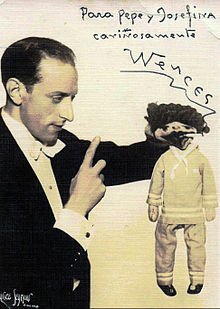Senor Wences
| Señor Wences | |
|---|---|

Wences in 1935 with an early version of Johnny
|
|
| Born |
Wenceslao Moreno April 17, 1896 Peñaranda de Bracamonte, Salamanca, Spain |
| Died | April 20, 1999 (aged 103) New York City, New York, U.S. |
| Occupation | Ventriloquist and comedian |
| Years active | 1937–1986 |
| Known for | Ventriloquism |
| Spouse(s) | Esperanza Martin (1922–1944) Natalie Cover, nee Eisler (1951) |
Wenceslao Moreno (April 17, 1896 – April 20, 1999), better known as Señor Wences, was a Spanish ventriloquist. His popularity grew with his frequent appearances on CBS-TV's The Ed Sullivan Show in the 1950s and 1960s.
Wenceslao Moreno was born in Peñaranda de Bracamonte, Salamanca, Spain. His father was Antonio Moreno Ross, and his mother was Josefa Centeno Lavera. Both parents were born in the province of Salamanca, his father in Peñaranda de Bracamonte and his mother in Cordovilla. Señor Wences's family on both sides are Roman Catholic. Señor Wences was one of the benefactors of the Convent of Saint Teresa of Avila (1515-1582) in Alba de Tormes, Salamanca, where he had a house. He attended mass there every Sunday when on vacation during the Summer. The street that leads to the convent received the name of Señor Wences while he was alive. There are several other places in Salamanca and in Castille that have streets named after him.
Performing under the stage name "Señor Wences", Moreno was known for his speed, skill, and grace as a ventriloquist. His stable of characters included Johnny, a childlike face drawn on his hand, placed atop an otherwise headless doll, with whom the ventrilloquist conversed while switching voices between Johnny's falsetto and his own voice with great speed. He opened his act by drawing Johnny's face on his hand, on stage. He would first place his thumb next to, and in front of, his bent first finger; the first finger would be the upper lip, and the thumb the lower lip. He used lipstick to draw the lips onto the respective fingers and then drew eyes onto the upper part of the first finger, finishing the effect with a tiny long-haired wig on top of his hand. Flexing the thumb would move the "lips."
Another popular Señor Wences character was the gruff-voiced Pedro, a disembodied head in a box. Wences was forced to suddenly invent the character when his regular, full-sized dummy was destroyed during a 1936 train accident en route to Chicago. Pedro would either "speak" from within the closed box, or speak with moving lips – simply growling, "s'awright" ("it's all right") – when the performer opened the box's front panel with his free hand. A large part of the entertainer's comedy lay in the well-timed, high-speed exchange of words between himself and his creations, and in the difference in their voice pitches.
...
Wikipedia
